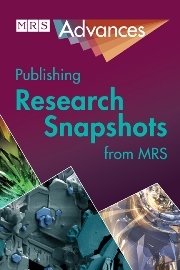Article contents
A Thermodynamic Analysis on the Swelling Stress of Na-Bentonite under Various Solution Conditions
Published online by Cambridge University Press: 20 February 2017
Abstract
The swelling stress of bentonite which is one of the engineered barriers and backfill materials for radioactive waste disposal is strongly dependent on water chemistry such as saline water. The authors have developed a thermodynamic model for calculating the swelling stress (pressure) of bentonite, based on the thermodynamic data of interlayer water in Na-montmorillonite obtained in earlier studies. In this work, the swelling stress of water-saturated Na-bentonite was calculated for various bentonite dry densities and solution conditions such as sodium chloride concentration and nitrate concentration and compared to the measured data.
Swelling stress versus montmorillonite partial density was estimated for solutions containing sodium chloride ([NaCl] = 0−3.4 m, m: molality) and nitrate concentrations ([NaNO3] = 0−6 m) and compared to data measured for bentonites with various montmorillonite contents and silica sand contents. The calculated swelling stresses commonly decreased with increasing [NaCl] and [NaNO3] for the same montmorillonite partial density. The trend of swelling stress versus [NaCl] was in a good agreement with the measured results. The calculated swelling stress versus [NaCl] was also quantitatively in a good agreement within the scattering of the measured data. The trend versus [NaNO3] was also similar to that versus [NaCl]. However, the calculated results were quantitatively different from the measured data ([NaNO3] = 3, 5 m, montmorillonite partial density = 0.76−0.87 Mg/m3). Even though those measurements were conducted under the condition of high ionic strength, the measured data of swelling stresses were almost the same as in the condition of distilled water. Since the measurement periods were quite rather short, it is conceivable that the measurements were not done at equilibrium.
- Type
- Articles
- Information
- MRS Advances , Volume 1 , Issue 61: Scientific Basis for Nuclear Waste Management XXXIX , 2016 , pp. 4019 - 4025
- Copyright
- Copyright © Materials Research Society 2017
References
REFERENCES
- 1
- Cited by


